heating CADILLAC FLEETWOOD 1996 2.G Owners Manual
[x] Cancel search | Manufacturer: CADILLAC, Model Year: 1996, Model line: FLEETWOOD, Model: CADILLAC FLEETWOOD 1996 2.GPages: 306, PDF Size: 15.72 MB
Page 105 of 306
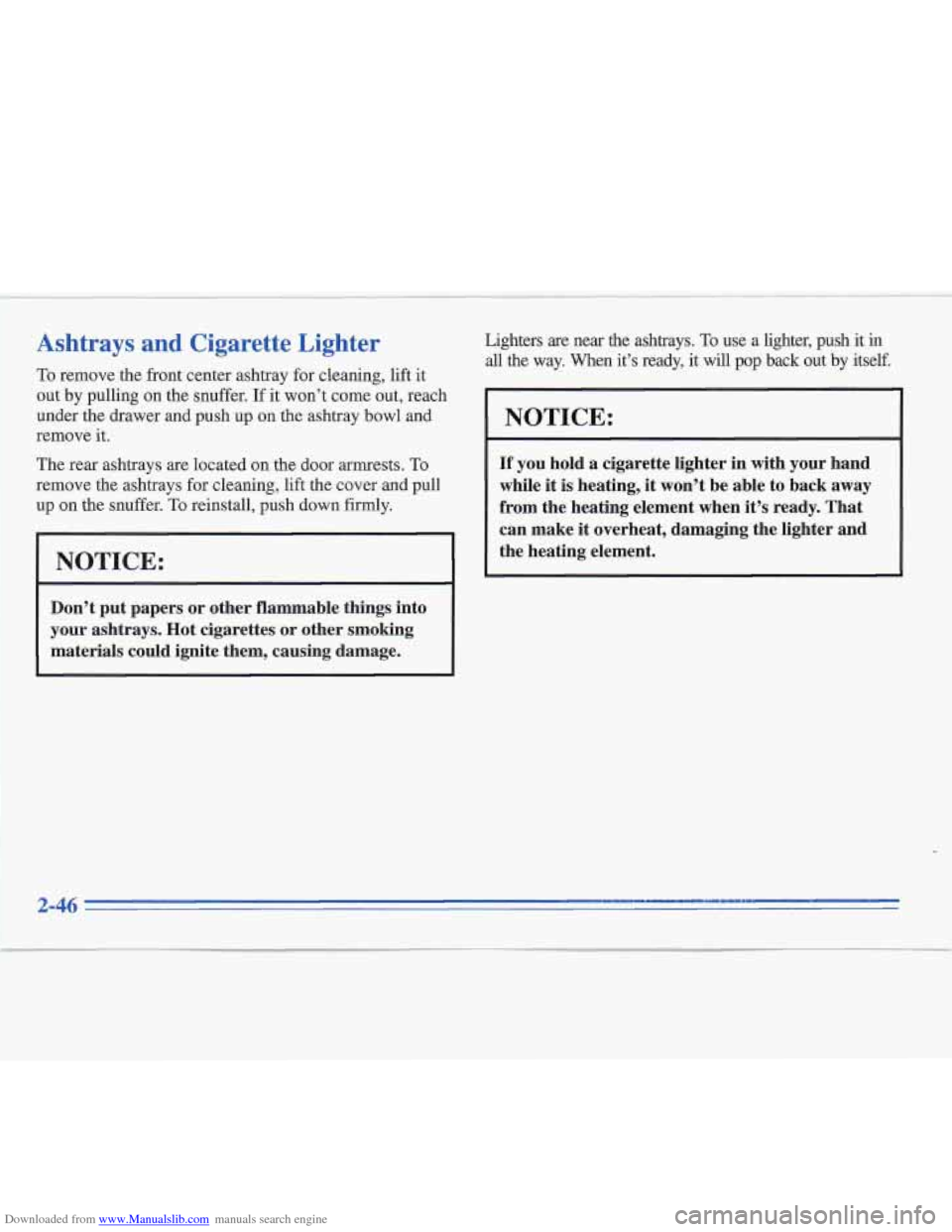
Downloaded from www.Manualslib.com manuals search engine Ashtrays and Cigarette Lighter
To remove the rront center ashtray for cleaning, lift it
out by pulling on the snuffer. If it won’t come out, reach
under the drawer and push up on the ashtray bowl and
remove it
.
The rear ashtrays are located on the door armrests. To
remove the ashtrays for cleaning, lift the cover and pull
up on the snuffer.
To reinstall, push down firmly.
NOTICE:
Don’t put papers or other flammable things into
your
ashtrays. Hot cigarettes or other smoking
materials could ignite them, causing damage.
Lighters are near the ashtrays. To use a lighter, push it in
all the way. When it’s ready, it will pop back out by itself.
NOTICE:
If you hold a cigarette lighter in with your hand
while it
is heating, it won’t be able to back away
from the heating element when
it’s ready. That
can make
it overheat, damaging the lighter and
the heating element.
2-46
Page 118 of 306

Downloaded from www.Manualslib.com manuals search engine Engine Coolant Temperature Warning Light
h k -
TEMP
This light should come
on briefly as a bulb check
when you start the engine.
This light tells you that
your engine coolant
has overheated.
Low Coolant Warning Light
LOW
COOLANT
If the coolant level in the
radiator is low, this light
will come on and stay on
until you add coolant.
Continuing
to drive your
vehicle with this warning
light on may result in
damage to your engine.
If you have been operating your vehicle under normal
driving conditions, you should pull
off the road, stop
your vehicle and turn the engine
off as soon as possible.
In “Problems on the Road,” this manual shows you what
to do.
See “Engine Overheating” in the Index. See
“Engine Coolant” in the Index and have your
vehicle serviced as
soon as you can.
2-59
Page 128 of 306
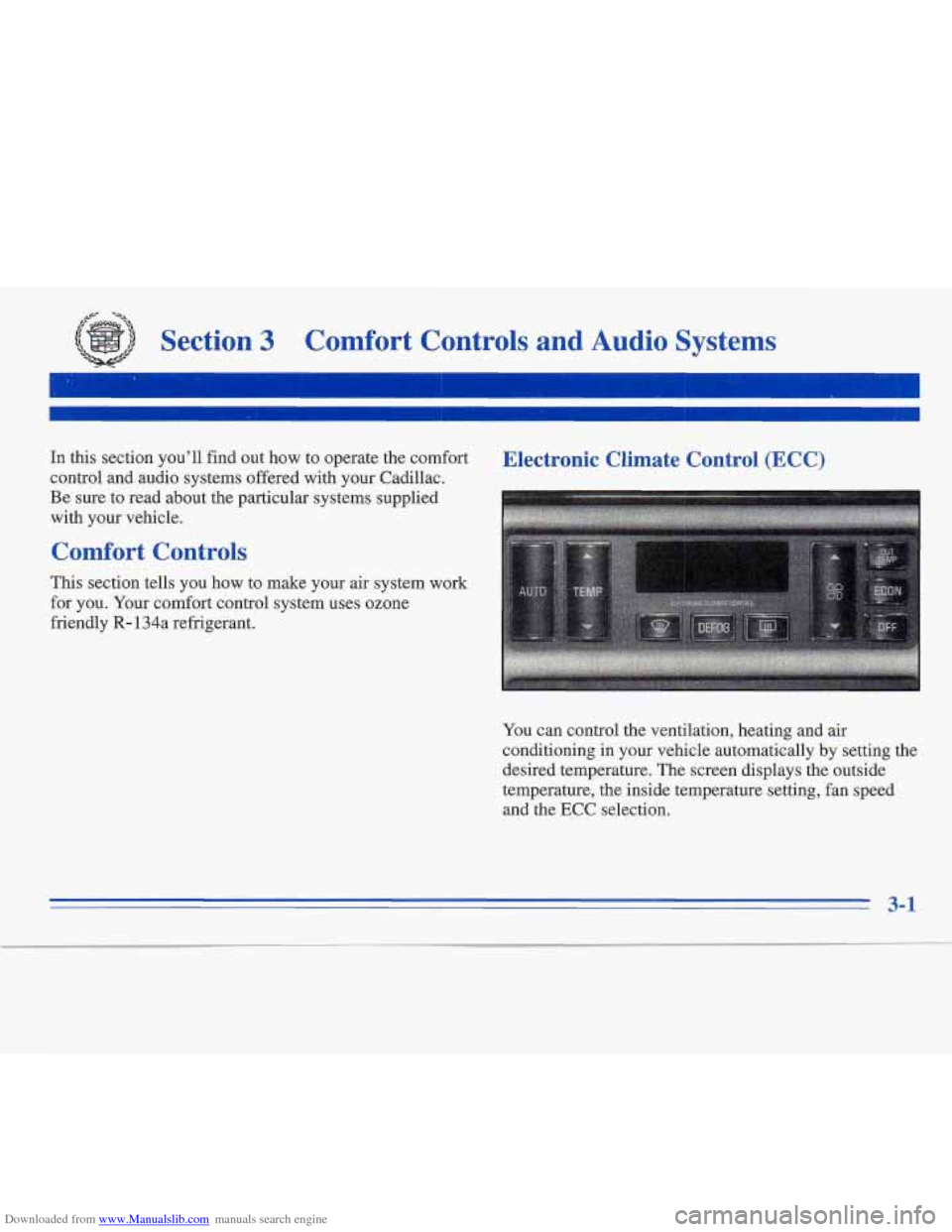
Downloaded from www.Manualslib.com manuals search engine ,+- -%
Section 3 Comfort Controls and Audio Systems
In this section you’ll find out how to operate the comfort
control and audio systems offered with your Cadillac.
Be sure to read about the particular systems supplied
with your vehicle.
Comfort Controls
This section tells you how to make your air system work
for
you. Your comfort control system uses ozone
friendly
R- 134a refrigerant.
Electronic Climate Control (ECC)
I
You can control the ventilation, heating and air
conditioning
in your vehicle automatically by setting the
desired temperature. The screen displays the outside
temperature, the inside temperature setting,
fan speed
and the
ECC selection.
3-1
Page 129 of 306

Downloaded from www.Manualslib.com manuals search engine 1
OUT TEMP: Press this to display the outside
temperature. Press it again to return to the regular
system display.
TEMP: This sets the interior temperature you want.
Press the lower portion to lower the inside temperature
setting. Press the upper portion to raise the temperature
setting. Once you set the temperature, the system will
automatically maintain the set temperature.
You can change the temperature from
65 OF (1 8 O C) to
85 OF (29"C), one degree at a time. You may also choose
60 OF ( 16 O C) for maximum cooling or 90 OF (33 O C) for
maximum heating. The fan will stay on high speed
unless you select a different speed. In maximum heating,
most of the air will flow out the heater outlets. In
maximum cooling, the system will recirculate the air
inside your vehicle instead of pulling air from outside.
OFF: This turns off anything set in the ECC, but air will
flow through your Cadillac.
ECON: Use this in cold or cool weather to save fuel. It
won't cool or remove humidity from the air. However,
the system will try to keep the air at the chosen
temperature. If it's
so warm outside that you need to
cool the air, use AUTO.
AUTO: With this setting, the system automatically
controls the temperature, air distribution and fan
speeds. In cold conditions, the fan will not come on
until the system senses that the engine has started to warrn up. This prevents cold air from blowing on you
and your passengers.
FAN: The fan speed is controlled automatically if
you have the ECC set
on AUTO. However, if you want
the fan to run at a lower speed, press the lower portion
of the fan switch.
If you want the blower to run at a fixed higher speed,
press the upper portion
of the fan switch until you see
HI on the display.
If you want the fan to run at a fixed low speed, press the
switch until
LO is shown on the display.
If you want the fan speed to be automatic but you like
the fan to be higher or lower than the AUTO settings,
just press the switch until either HI AUTO or AUTO
LO
is displayed.
If the Fahrenheit
(F") or Celsius (C")
flash, or flashes when you turn
on the symbol begins to
ignition, it
indicates an electrical problem with your air
conditioning system. The flashing will continue for
about two minutes. It means you should have your
system serviced.
Page 184 of 306
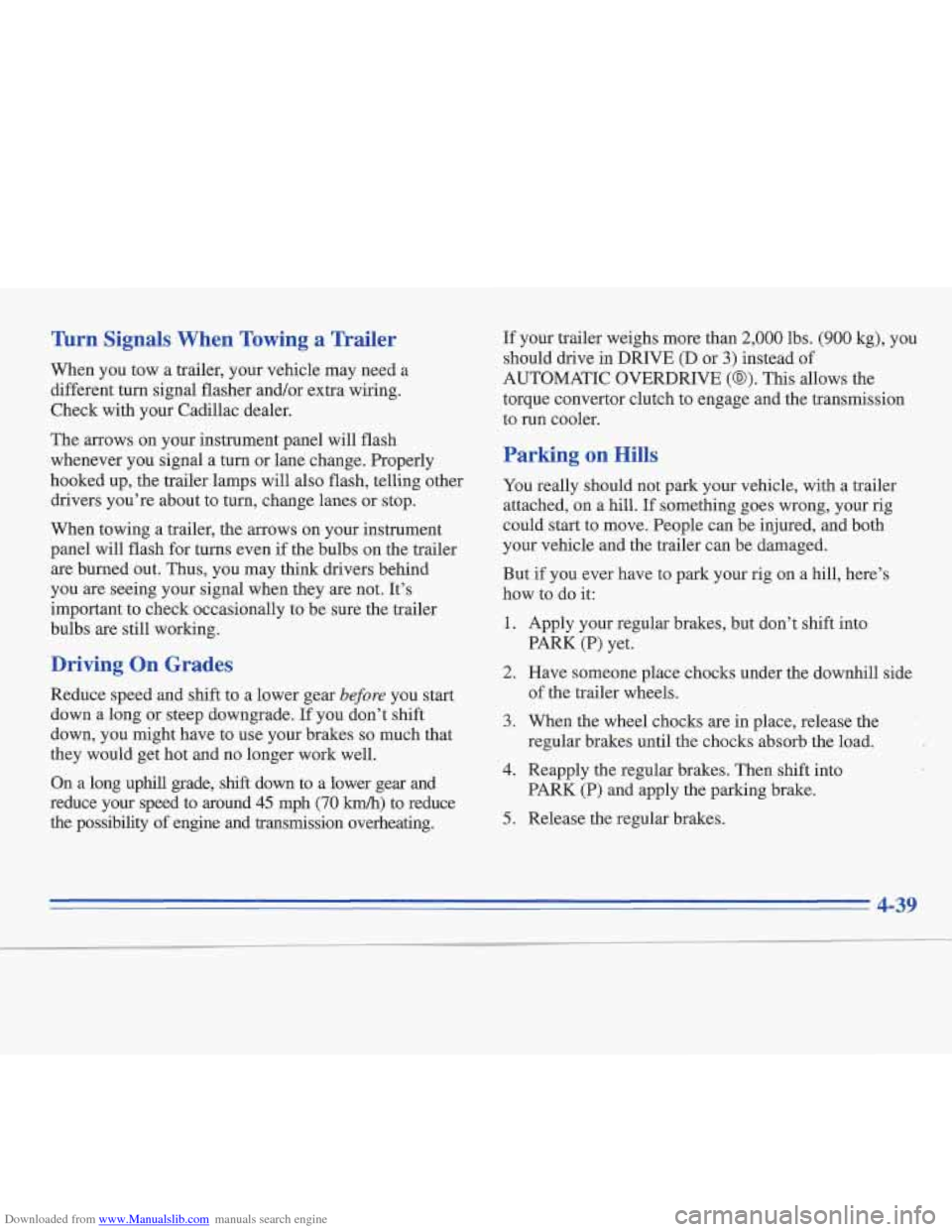
Downloaded from www.Manualslib.com manuals search engine Turn Signals When Towing a Trailer
When you tow a trailer, your vehicle may need a
different turn signal flasher and/or extra wiring.
Check with your Cadillac dealer.
The arrows on your instrument panel will flash
whenever you signal a turn or lane change. Properly
hooked up, the trailer lamps will also flash, telling other
drivers you’re about to turn, change lanes or stop.
When towing a trailer, the arrows on your instrument
panel will flash for turns even if
the bulbs on the trailer
are burned out. Thus, you may think drivers behind
you are seeing your signal when they are not. It’s
important to check occasionally to be sure the trailer
bulbs
are still working.
Driving On Grades
Reduce speed and shift to a lower gear before you start
down a long or steep downgrade. If you don’t shift
down, you might have to use your brakes
so much that
they would get hot and no longer work well.
On a long uphill grade,
shift down to a lower gear and
reduce your speed to around
45 mph (70 km/h) to reduce
the possibility of engine and transmission overheating.
If your trailer weighs more than 2,000 lbs. (900 kg), you
should drive in DRIVE
(D or 3) instead of
AUTOMATIC OVERDRIVE (@). This allows the
torque convertor clutch to engage and the transmission
to run cooler.
Parking on Hills
You really should not park your vehicle, with a trailer
attached, on a hill. If something goes wrong, your rig
could start to move. People can be injured, and both
’
your vehicle and the trailer can be damaged.
But if you ever have to park your rig on a hill, here’s
how to do
it:
1. Apply your regular brakes, but don’t shift into
2. Have someone place chocks under the downhill side
PARK
(P) yet.
of the trailer wheels.
3. When the wheel chocks are in place, release the
regular brakes until the chocks absorb the load.
4. Reapply the regular brakes. Then shift into
PARK (P) and apply the parking brake.
5. Release the regular brakes.
Page 200 of 306

Downloaded from www.Manualslib.com manuals search engine The coolant level should be at or above the FULL
COLD mark. If it isn’t, you may have a leak in the
radiator hoses, heater hoses, radiator, water pump or
somewhere else in the cooling system.
I/“. CArnQ!y: ,;~:!
$21 >p ,”/’
_,J’ =
Heater and radiator hoses, and other engine
parts, can be very hot. Don’t touch them.
If you
do, you can be burned.
Don’t run the engine if there is a leak. If you run
the engine, it could lose all coolant. That could
cause an engine fire, and you could be burned.
Get any leak fixed before you drive the vehicle.
I NOTICE: I
Engine damage from running your engine
without coolant isn’t covered by your warranty.
If there seems to be no leak, with the engine on, check to
see if the electric engine fan(s) are running. If the engine
is overheating, both fan(s) should be running.
If they
aren’t, your vehicle needs service.
Page 237 of 306
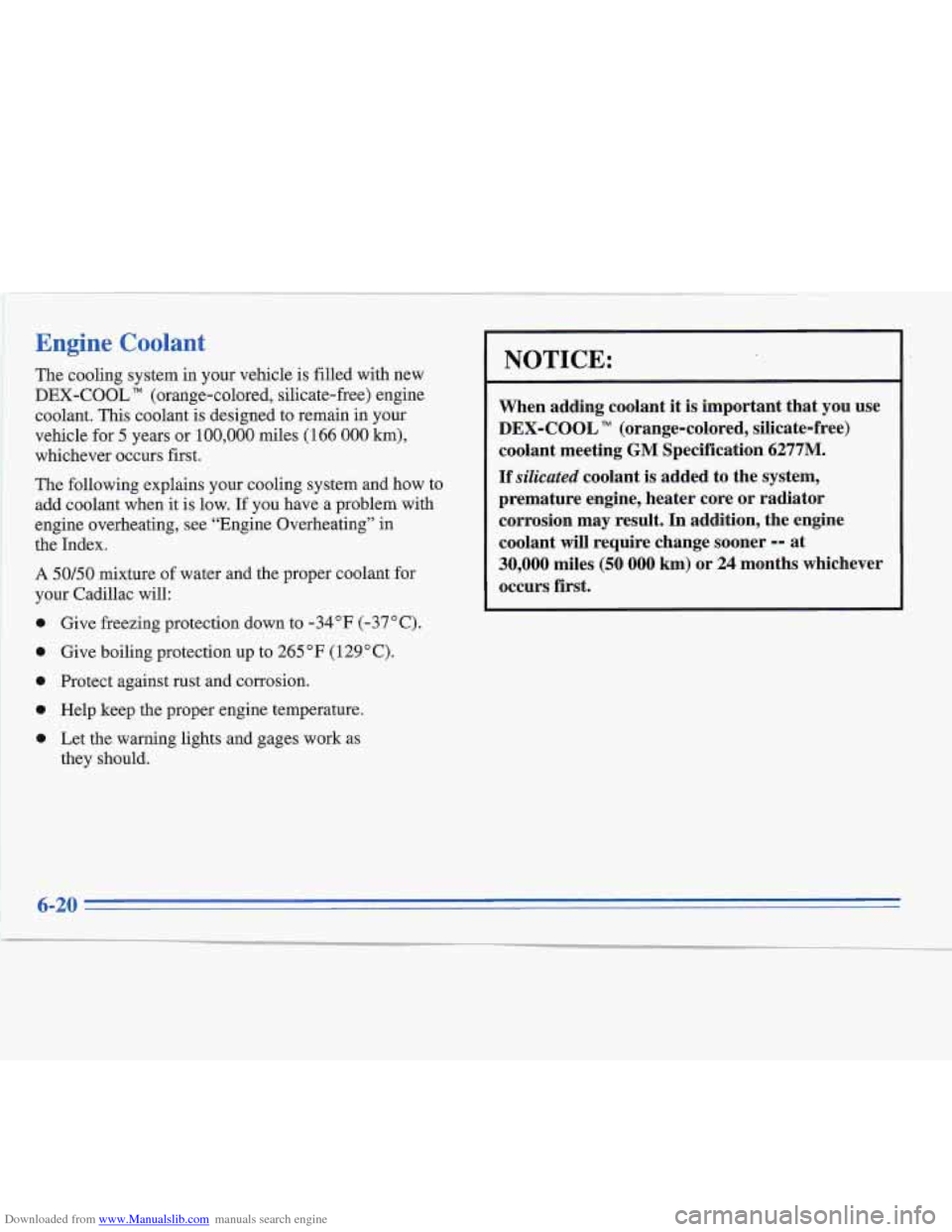
Downloaded from www.Manualslib.com manuals search engine Engine Coolant
The cooling system in your vehicle is filled with new
DEX-COOL
TM (orange-colored, silicate-free) engine
coolant.
This coolant is designed to remain in your
vehicle for
5 years or 100,000 miles (166 000 km),
whichever occurs first.
The following explains your cooling system and how to
add coolant when it is low. If you have a problem with
engine overheating, see “Engine Overheating” in
the Index.
A 50/50 mixture of water and the proper coolant for
your Cadillac will:
0
0
0
0
0
Give freezing protection down to -34°F (-37°C).
Give boiling protection up to 265
” F ( 129 O C).
Protect against rust and corrosion.
Help keep the proper engine temperature.
Let the warning lights and gages work as
they should.
6-20
Page 240 of 306
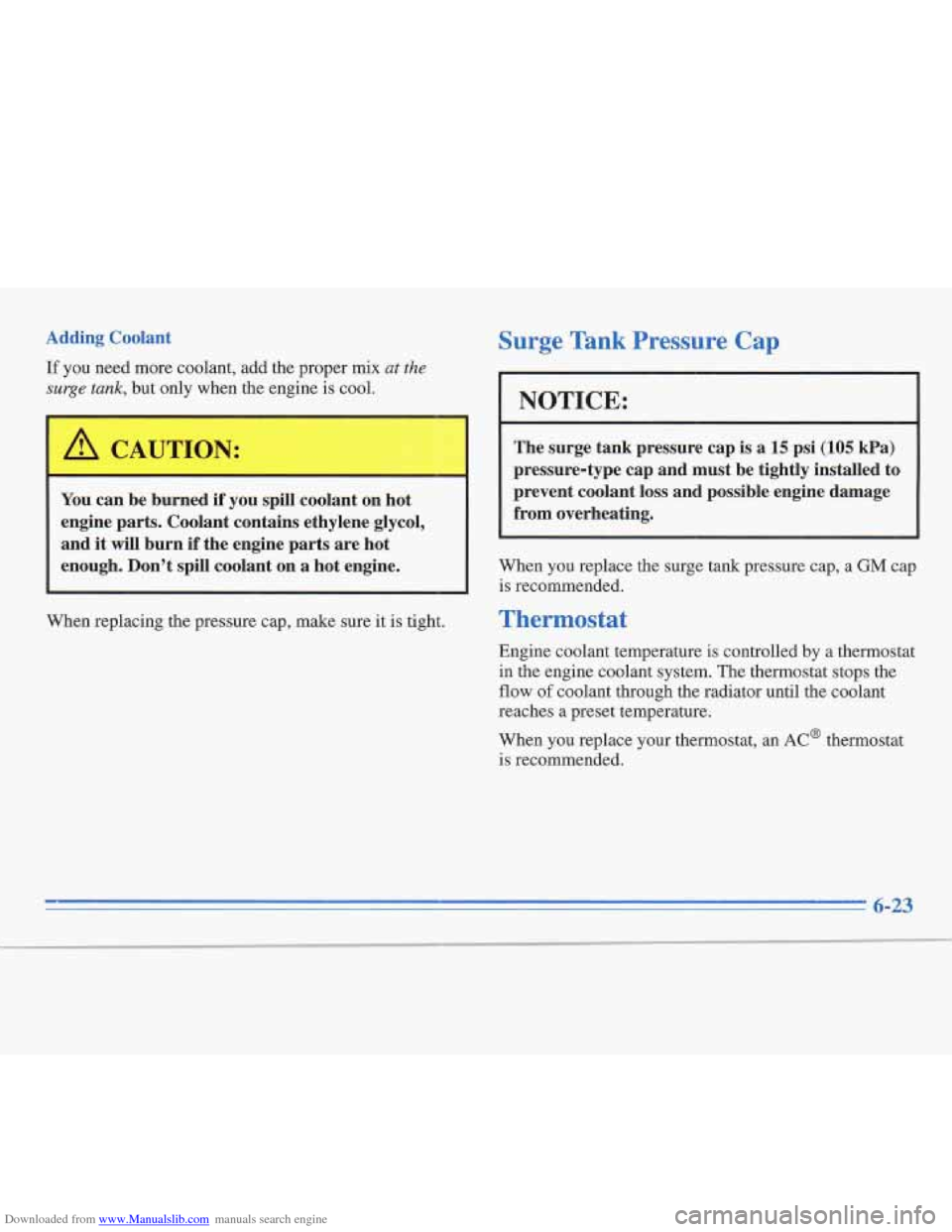
Downloaded from www.Manualslib.com manuals search engine Adding Coolant
If you need more coolant, add the proper mix at the
surge tank, but only when the engine is cool.
I
You can be burned if you spill coolant on hot
engine parts. Coolant contains ethylene glycol,
and
it will burn if the engine parts are hot
enough. Don’t spill coolant on a hot engine.
When replacing the pressure cap, make sure it is tight.
Surge Tank Pressure Cap
NOTICE:
The surge tank pressure cap is a 15 psi (105 kPa)
pressure-type cap and must be tightly installed to
prevent coolant loss and possible engine damage
from overheating.
When you replace the surge tank pressure cap, a GM cap
is recommended.
Thermostat
Engine coolant temperature is controlled by a thermostat
in the engine coolant system. The thermostat stops the
flow of coolant through the radiator until the coolant
reaches a preset temperature.
When you replace your thermostat, an
AC@ thermostat
is recommended.
6-23
Page 256 of 306

Downloaded from www.Manualslib.com manuals search engine 2. Insert a screwdriver into the slot as shown and press
down to release
the wiper blade assembly from
the arm.
3. Align the wiper arm pin with the hole on the wiper
blade assembly and snap it into place to install.
Tires
We don’t make tires. Your new Cadillac comes with
high-quality tires made by a leading tire manufacturer. If
you ever have questions about your tire warranty and
where to obtain service, see your Cadillac Warranty
booklet for details.
A CAUTION:
0
0
0
0
Poorly maintained and improperly used tires
are dangerous.
Overloading your tires can cause
overheating as
a result of too much friction.
You could have an air-out and a serious
accident. See “Loading Your Vehicle” in
the Index.
Underinflated tires pose the same danger
as
overloaded tires. The resulting accident
could cause serious injury. Check all tires
frequently to maintain the recommended
pressure. Tire pressure should be checked
when your tires are cold.
Overinflated tires are more likely to be cut,
punctured or broken
by a sudden
impact
-- such as when you hit a pothole.
Keep tires
at the recommended pressure.
Worn, old tires can cause accidents.
If your
tread is badly worn, or if your tires have
been damaged, replace them.
6-39
Page 301 of 306
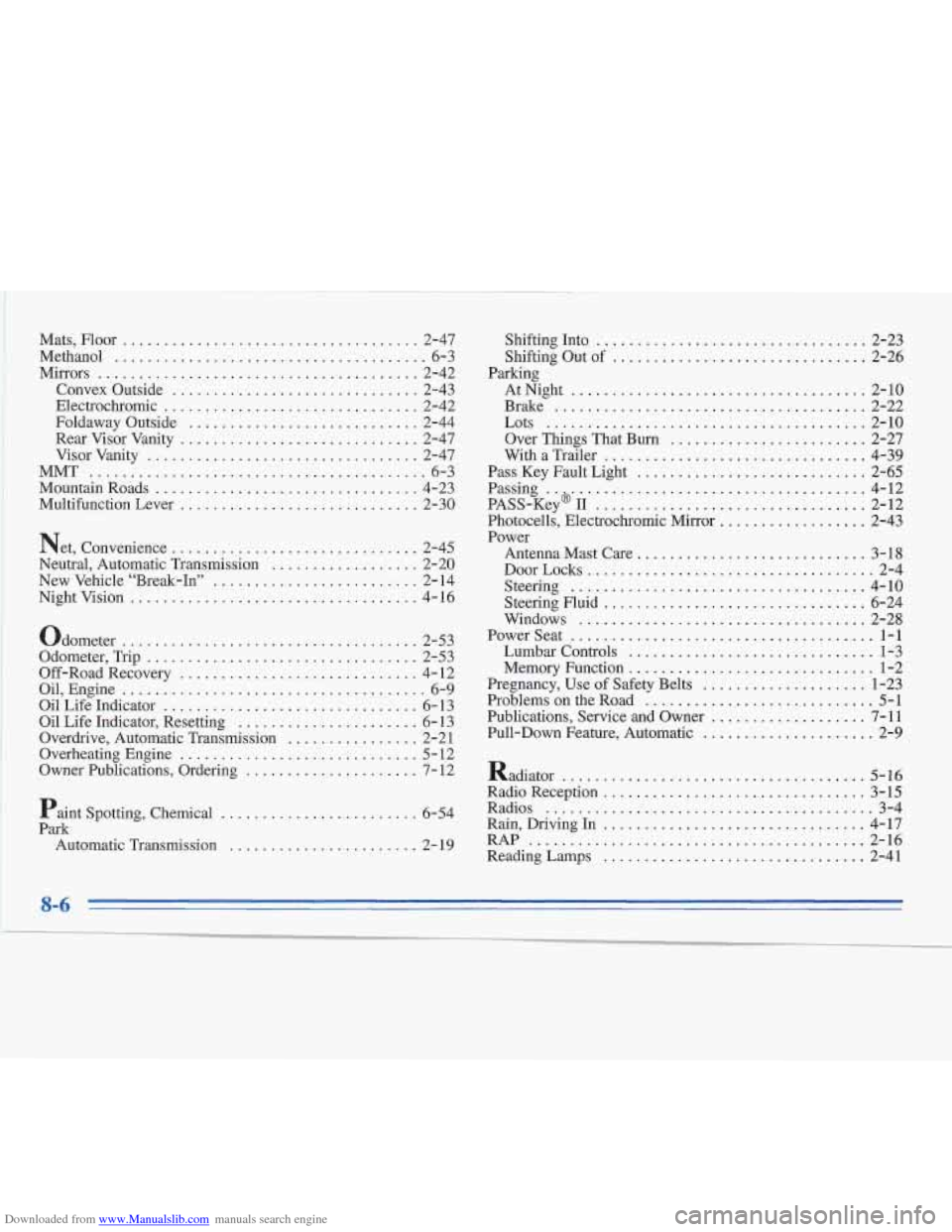
Downloaded from www.Manualslib.com manuals search engine Mats. Floor .................................... 2-47
Methanol
...................................... 6-3
Mirrors
....................................... 2-42
Convex Outside
.............................. 2-43
Electrochromic
............................... 2-42
Foldaway Outside
............................ 2-44
Rear Visor Vanity
............................. 2-47
Visor Vanity
................................. 2-47
MMT
......................................... 6-3
MountainRoads
................................ 4-23
Multifunction Lever
............................. 2-30
Net. Convenience
.............................. 2-45
Neutral. Automatic Transmission
.................. 2-20
New Vehicle “Break-In”
......................... 2-14
Nightvision
................................... 4- 16 Shifting Into
................................. 2-23
Shifting Out
of ............................... 2-26
AtNight
.................................... 2-10
Brake
...................................... 2-22
Lots
....................................... 2-10
Over Things That Burn
........................ 2-27
With a Trailer
................................ 4-39
Pass Key Fault Light
............................ 2-65
Passing
..&.................................... 4-12
PASS-Key
I1 ................................. 2-12
Photocells, Electrochromic Mirror
.................. 2-43
Power Antenna Mast Care
............................ 3-18
DoorLocks
................................... 2-4
Steering
.................................... 4-10
Steering Fluid
................................ 6-24
Windows
................................... 2-28
Parking
..................................... Odometer .................................... 2-53
Powerseat 1-1
Odometer, Trip ................................. 2-53 Lumbar Controls 1-3
Off-RoadRecovery
............................. 4-12 Memory Function 1-2
Oil, Engine
..................................... 6-9 Pregnancy, Use of Safety Belts 1-23
Oil Life Indicator
............................... 6-13 Problems on the Road 5-1
Oil Life Indicator, Resetting
...................... 6- 13 Publications, Service and Owner 7-11
Overdrive. Automatic Transmission
................ 2-21 Pull-Down Feature, Automatic 2-9
..............................
..............................
....................
............................
...................
.....................
Overheating Engine ............................. 5- 12
Owner Publications. Ordering
..................... 7- 12
Paint Spotting. Chemical
........................ 6-54
Park Automatic Transmission
....................... 2- 19 Radiator
..................................... 5-16
Radio Reception
................................ 3-15
Rain. Driving In
................................ 4-17
Radios
........................................ 3-4
RAP
......................................... 2-16
ReadingLamps
................................ 2-41
{ 8-6